It is sad that The Last Man on Earth has now become synonymous with a television series that features so many characters that it is shocking that they decided on that title. That’s not to put down the show; I’ve never seen it and it looks like it would be an enjoyable comedy. But The Last Man on Earth is now and always will be the 1964 classic starring Vincent Price. It was the first psychotronic film I ever saw — at the age of 5. And I had nightmares about it for years. Any film that gives children nightmares for years can’t be all bad and is probably really good. The Last Man on Earth is great.
The Last Man on Earth was the first of at least four adaptations of Richard Matheson’s now classic 1954 novel I Am Legend. (At the time of its release, it was not terribly well reviewed — but then, horror and science fiction has not traditionally received the highest of praise when first released.)
The Pretenders
The others are (in chronological order):
The Omega Man (1971)
This is a fun movie. What’s not to like about Charlton Heston firing a machine gun in a deserted city, watching Woodstock, and making it with Rosalind Cash? And Anthony Zerbe as the bad guy leading “The Family” (I didn’t say it was a subtle film!) is great.
I could do without the “Christ died so we could live” symbolism at the end. (There is a hint of that in The Last Man on Earth too.) But at least there’s lots of blood and action! It’s well worth watching, even if it is cinematic candy that doesn’t reward repeated consumption.
I Am Omega (2007)
This is pretty much a remake of The Omega Man starring Mark Dacascos. And it is rather good. But the southern hick survivalist is enough to offend even this left coaster’s sense of fair play. I suppose you can see it as a double-fake: obviously, he’s the bad guy so he can’t be the bad guy. But he is!
Still, a pretty entertaining outing from The Asylum. And sure The Asylum knew that the big-budget Will Smith picture was coming out, so they made this one. First, this is hardly a new thing. Second, they made a surprisingly professional film in a few months for about 1/200th as much as the Will Smith film.
I Am Legend (2007)
This film is not horrible. I thought the scene when he was looking for his dog (a minor shout out to the novel) was quite suspenseful. But how could it not be? I mean, JR Bookwalter could have done that in an afternoon with pocket change.
It’s a perfectly acceptable Hollywood action/suspense film. There was nothing special about it, except that it had a star. And Will Smith was fine. He’s pleasant to look at. But so is Mark Dacascos.
But it didn’t have a redneck who keeps his dead friend around for company. Which would you rather watch?
True to the Novel
The interesting thing about these three is that they stray far from the novel. The Omega Man seems to be more the basis of the two 2007 films than anything that Matheson had in mind. Yet the Will Smith monstrosity has the gall to call itself by the original novel’s title, even though it makes absolutely no sense given the narrative — even if it had ended with the much better director’s version.
This is not to say The Last Man on Earth is slavishly committed to the book. In particular, the film ends with an action scene and the book ends reflectively. Just the same, you can see in it why the novel was titled as it was with Vincent Price’s last line, “They were afraid of me.” Not as good as the book, but we don’t judge films against books. My point is simply that of the four films supposedly based on the book, only the first was true to the sense of the book.
The Plot of The Last Man on Earth
Here we go again. Some people don’t like spoilers. It’s weird because no one ever says, “Don’t tell me how Romeo and Juliet ends!” Shakespeare himself tells you in the sixth line of the play, “A pair of star-crossed lovers take their life.” But I am nothing if not accommodating. So I hide the plot from those of you who don’t want to see it.
The truth is, I mostly create the synopses for people who want to write about the films but can’t remember some detail. That’s why they are often long. And also why many people won’t want to see them even if they don’t care about spoilers. So read or skip. But know this: it’s about the last man on Earth. Kind of.
Analysis
Fundamentally, there is nothing terribly different between The Last Man on Earth and Robinson Crusoe. In both cases, the “man alone” tries to maintain the society that was lost. In the case of Morgan, it doesn’t make a lot of sense.
The vampires are killing each other. What is the point of trying to wipe them out? They don’t pose a threat to him. Indeed, if he just moved, they likely wouldn’t be able to find him.
Given that he believes he is the last person on Earth, he must think that humanity dies when he dies. Yet he still goes around disposing of these vampires.
(In the book it is worse because he actually can tell that there are two kinds of creatures he’s killing: those that breathe and those that don’t. It makes the denouement that much worse.)
But rather than doing something more edifying, Morgan chooses to do what is, intellectually at least, easy: dispose of the undead — something the government was doing when he was searching for a cure.
In this way, I see it as something of a critique of society. The system must be kept going, even when it makes no sense. It is work for the sake of work. It is a mouse on a spinning wheel.
Schopenhauer’s Paradox

To get a little philosophical, Morgan represents Arthur Schopenhauer’s ultimate paradox. We struggle through today so we can live another day to do it all over again. Morgan is quite explicit about this. At the start of his second day in the film, he says, “Another day. Another day to start all over again!”
But at least in the modern world, there’s a problem with Schopenhauer’s paradox: life is not a complete drag. We don’t just eat to avoid starving; most of us enjoy eating. There is entertainment. There is the interaction with other humans.
Morgan has none of that. There is no joy in his life until the dog shows up and that quickly goes away. We see none of the kind of self-enjoyment that Zac does in The Quiet Earth. And after he has his fun, he works to fix the problem. Killing vampires is not going to fix the problem. Zac is taking measurements and doing calculations. But if he acted like Morgan, he would have become a garbage collector.
Lonliness
Ultimately, I think The Last Man on Earth is about loneliness. Morgan is never so happy as he is after he cures Ruth, “We won’t be alone! We’ll never be alone again!”
I think he goes on killing the vampires because it is the closest that he can come to human contact. (This is explicit in the book where the main thing you could call entertainment for him is staying close to home and searching for Ben; he says he hopes he doesn’t find him, not because he minds killing Ben, but because this pleasant activity will be gone.) But there’s no indication that he understands this.
Even the vampires banging on his door and breaking his windows keeps him in touch with humanity.
The Making of The Last Man on Earth
There are some strange things in The Last Man on Earth.
Evolution in the Novel, Evolution in the Script
A good example of this is the issue of evolution, which is fundamental to the novel.
We always see evolution from the standpoint of the species that survive — because we are one of them. The novel turns it around and shows us what it is like for a species to die off.
We see the issue of evolution in the film, but it is dropped. Dr Mercer notes that there is some evolutionary process going on.
But this idea makes no sense once Morgan cures Ruth. The implication of the ending is that there will not be some new species (or subspecies) but rather, Ruth (via Morgan) will restore humanity.
The Screenplay
This is no doubt due to the screenplay rewrites.
At first, Richard Matheson wrote the screenplay for the legendary Hammer Film Productions. It was going to be produced by Anthony Hinds (son of Hammer’s co-founder William Hinds). But they learned that the British censors would not allow the film. So they sold it to movie theater tycoon and film producer Robert Lippert.
At that point, I suspect the script was quite true to the novel. Indeed, I wonder why it is that no one has made a close film adaptation of the novel. It would work really well. Instead, the films just get further and further away from the source material.
But after Lippert got the script, it was going to be made by Associated Producers Incorporated (API), a subsidiary of 20th Century-Fox, created to make low-budget, “B,” pictures. The budget for these films was generally about $100,000. And they were shot over the course of a week with reshoots rare. So I’m sure the script was rewritten, by William Leicester, with cost in mind. This was the only feature film that Leicester ever wrote. But he was a highly successful television writer — a perfect choice to convert a Hammer film into an API film.
I suspect the film was also changed because it would play better on the drive-in circuit to end with a big chase and Vincent Price being impaled with a pike. The end of the novel is contemplative with a tender scene with Ruth visiting him in jail and giving him some pills that will kill him painlessly before he can be executed. It could be made to work even for the action film crowd. But it is an entirely different location and it really doesn’t change how the story ends.
Rome as Los Angeles
Matheson’s novel takes place in Los Angeles. And that’s where the screenplay was based. This caused some problems as Vincent Price discussed in an interview with Tom Weaver in Attack of the Monster Movie Makers:
The problem doing The Last Man on Earth was that it was supposed to be set in Los Angeles, and if there’s a city in the world that doesn’t look like Los Angeles, it’s Rome. [laughs.] We would get up and drive out at five o’clock in the morning, to beat the police, and try to find something that didn’t look like Rome. Rome has flat trees, ancient buildings — we had a terrible time! And I never was so cold in my life as I was in that picture I had a driver and I used to tip him a big sum to keep the car running, so I could change my clothes in the back seat.

The Director(s)
According to Matheson, Lippert was planning to get Fritz Lang to direct the film. He would have said that in the late 1950s — probably 1957. Fritz Lang’s last film as director was in 1960 — the exceptional The Thousand Eyes of Dr Mabuse. But by this point, Lang was going blind. Even if he had been willing to make The Last Man on Earth[2] he wasn’t really capable of doing it by the time it was actually shot in 1961.[3]
So, according to Matheson in Return of the B Science Fiction and Horror Heroes, they got Sidney Salkow. But here we run into a problem. On English-language prints of The Last Man on Earth, Salkow is indeed listed as the director. On Italian-language prints of L’Ultimo Uomo Della Terra, Ubaldo Ragona is listed as director. (See below for a comparison of the credits in the two versions.)
The Art of Dubbing
In order to get a handle on the situation, we need to understand how films were made in Italy. The industry there did not embrace sync sound. So films were shot silent and then dubbed in the studio. As a result, the Italians got really good at dubbing.
When dubbing is brought up, people tend to think of dashed-off English dubs of Japanese films — where the words have almost no connection to the movement of the lips. This is not necessary. For example, The Bicycle Theives is beautifully dubbed in its original language.[4] It is also beautifully dubbed in English. I doubt that most people who watch The Last Man on Earth notice that it is dubbed.
My Hypothesis
I’ve yet to find confirmation, but I suspect that Sidney Salkow did direct the film in the traditional sense of the word. My guess would be that Ragona took care of the dubbing. That’s no small feat. It isn’t just a technical matter; it requires directing the actors in their vocal performances. Actually: double the number of actors because different actors did the parts in the different languages. (This isn’t always the case.)
The only American actor in the film was Vincent Price. I assume all the Italian actors dubbed their own parts. But Ruth, played by Franca Bettoia in the film, was dubbed in English by Carolyn De Fonseca. I don’t know who dubbed Vincent Price in Italian, but it certainly isn’t Price. Dubbing is much like stunt work: something the film industry wishes to pretend doesn’t exist. We only know of Fonseca because dubbing English parts for the Italian film industry was almost her whole career and so she’s really well know. And she worked almost her entire career in Italy. (She also died there.)
Matheson wasn’t on the set. And Price didn’t talk about the film that much.
No Joint Directing — At That Time
Of course, it is possible that the two men jointly directed the film. But at that time, the Director’s Guild of America (DGA) would not allow more than one person named as “director.” (This is why the Coen brothers always showed Joel as the director and Ethan as the producer. In fact, all those films were co-directed and co-produced by the two of them — a fact that is backed up by many of the people who worked with them.) So maybe it was a joint project and they simply credited it that way for the sake of the DGA. (I don’t know of an Italian equivalent; many directors outside the US are members of the DGA, however.)
Credits
The credits listed for the US and Italian prints are quite different. So I’ve put together the following table for research purposes.
| Function | US | Italy |
|---|---|---|
| Director | Sidney Salkow | Ubaldo Ragona |
| Assistant Director | Carlo Grandone | Carlo Grandone |
| Screenwriters | Logan Swanson[5] and William Leicester | Furio Monetti and Ubaldo Ragona |
| Script Supervisor | Rita Agostini | |
| Director of Photography | Franco Delli Colli | Franco Delli Colli |
| Cameraman | Alvaro Lanzoni | |
| Assistant Cameraman | Angelo Lannutti[6] | |
| Sound Engineer | Enzo Silvestri | |
| Sound Recordist | Armando Timpani | |
| Boom operator | Bruno Zanoli | |
| Key Grip | Federico Tocci | |
| Chief Electrician | Renato Pietrini | |
| Syncronozation | Fonolux | |
| Editor | Gene Ruggiero | Franca Silvi |
| Music | Paul Sawtell and Bert Shefter | Paul Sawtell and Bert Shefter |
| Orchestration | Alfonso D’Artega | |
| Music Editor | Norman Schwartz | |
| Music Publishing | Nazionalmusic | |
| Art Director | Giorgio Giovannini | Giorgio Giovannini |
| Set Decoration | Brunello Serena | |
| Costume Designer | Lilli Menichelli | |
| Wardrobe | Carmen Frosali | |
| Make-Up | Piero Mecacci | Piero Mecacci |
| Producer | Robert Lippert | |
| Associate Producer | Harold Knox | |
| Production Manager | Vico Vaccaro | Vico Vaccaro |
| Assistant Production Manager | Lionello Meucci | Lionello Meucci |
| Production Supervisor | Luciano Volpato | |
| Production Secretary | Ermete Santini | |
| Soundstage | Titanus | |
| Development and Printing | Istituto Luce | |
| Photographer | Alfonso Avincola | |
| Starring | Vincent Price | Vincent Price |
| Co-starring | Franca Bettoia (Ruth), Emma Danieli (Virgina), Giacomo Rossi-Stuwart (Ben) | Franca Bettoia (Ruth), Emma Danieli (Virgina), Giacomo Rossi-Stuwart (Ben) |
| With | Umberto Raho (Dr Mercer), Christi Courtland (Kathy Morgan), Antonio Corevi (governor), Hector Ribotta (TV reporter) | Umberto Raho (Dr Mercer), Antonio Corevi (governor), Ettore Ribotta (TV reporter), Enrico Salvatore (?), Giuseppe Mattei (leader of the infected), Rolando De Rossi (?) |
Credit Comparison
There are a couple of interesting things here. The first is that, as usual for European films, there is more credit provided. What’s especially interesting, in a general sense, is that the camera operator is a greatly respected position in Hollywood. Yet they are relegated to the five or ten minutes of scrolling credits at the end of the film. So it’s nice to see that these and other artists are more publicly recognized outside the US.
The more interesting thing is that two different people are given credit for the same job depending upon what version we look at: director, screenwriters, and editor. I figure the Italian “screenwriters” just wrote the Italian dialog. (Note: one of them is the Italian director.)
Editing Differences
The differences between the English and Italian edits are small. There are three major differences and one minor. There were two scenes cut from the American version and one scene cut from the Italian version.
The minor difference is at the beginning of the chase at the end of the film. The Italian version has a slight bit more coverage of the pursuers. It’s just a few seconds and it isn’t clear why they were taken out of the American version.
Major Differences
Here are the major differences:
- After Morgan goes to the pit to try to get his daughter, he comes home and has a conversation with Virge. This goes on for about a minute and a half. I don’t speak Italian, so I don’t know what was said. But Morgan seems angry at first and becomes more understanding of what she did as the scene progresses.
- After Morgan tells Ruth about his theory of why he is immune, there is a conversation between the couple. It seems to be about Virge and what happened. This is also about a minute and a half long. Its absence in the English version is covered by an exterior shot of Ben banging on the door.
- In the American version, Morgan kills two of his pursuers as he runs up the steps of the 22nd Precinct building. This is cut from the Italian version. It goes from Morgan entering the building to his entering the armory. I have a feeling this might have been censored: it does show a guy with a gun killing two people. I rather like this cut because as I discussed in the synopsis: Morgan is acting stupidly by killing them. He is cutting off any hope that they would show him mercy.
It’s clear from the two versions that there was a final edit done by one or more people. It is definitely not true that the two versions had different editors. Small changes were made to some existing final cut of the film.
Why the Book Is Called I Am Legend
In the novel, Neville (Morgan in the film) is not chased and killed. He is captured and jailed, awaiting execution. Ruth, as in the movie, cares for him. She visits him and gives him pills that will kill him painlessly.
The novel ends:
Robert Neville looked out over the new people of the Earth. He knew he did not belong to them; he knew that, like the vampires, he was anathema and black terror to be destroyed. And, abruptly, the concept came, amusing to him even in his pain.
A coughing chuckle filled his throat. He turned and leaned against the wall while he swallowed the pills. Full circle, he thought while the final lethargy crept into his limbs. Full circle. A new terror born in death, a new superstition entering the unassailable fortress of forever.
I am legend.
It speaks extremely well of the movie that this idea comes across clearly, even though the phrase is never uttered. Instead, Morgan’s last words are, “They were afraid of me.” That is a less artful but clearer way of saying the same thing.
He didn’t intend to harm them. As he said, “I didn’t know.” That makes it all the more tragic.
Giacomo Favretto

At about 18:50 into the film, Morgan walks through his house and you can see a print on the wall. (It is seen elsewhere later — in particular in the flashback sequence.) It’s at least partly on the screen for 8 seconds, but it began to bug me that I didn’t know what it was. So through the use of a screenshot, some anti-skewing via gimp, reverse image searching on Google, and help from an artist friend of mine, I figured it out.
It is the painting Vandalismo by the Italian artist Giacomo Favretto (1849 – 1887). And that makes sense given that the film was shot in Rome. The painting won the Principe Umberto prize in 1880.
Where else but Psychotronic Review do people spend hours tracking down this kind of information about obscure films? Nowhere! Until someone notices it and adds it to Favetto’s Wikipedia page, “Giacomo Favretto’s painting Vandalismo is seen on a wall in the 1964 horror film The Last Man on Earth starring Vincent Price.” And if we’re lucky, we’ll get a nofollow link. Grrrr.
Continuity and Other “Errors”
Some people get very picky about what they see as errors in films — especially continuity errors. I’m not one of them.
Often Supposed Errors Aren’t
One of the reasons is that “continuity errors” often aren’t. For example, a famous one from The Last Man on Earth is when Morgan first goes to the pit. When he put the two corpses in the back of his car, they were facing inside. When he gets to the pit, the female is facing outward.
Is this a continuity error? You can call it one. But there is much missing action between Morgan leaving his house and arriving at the pit. Perhaps while fueling his car, he noticed that the female corpse had moved and was in danger of falling out. So he rearranged her position. Or maybe she fell out while he was driving and he had to put her back in.
Yes, it’s probably the case that it was simply better for blocking to remove the corpse with its head facing out. But I have a hard time calling this an error.
Having Fun With “Errors”
I do like that people watch films often and closely enough to notice really minor things.
Unfortunately, they are pretty much always presented as reasons to hate the film. As you will see in the following list of well-known “errors,” most were just decisions that had to be made to make the film better. The Last Man on Earth was a low-budget film. They certainly didn’t have the money to go back and reshoot scenes or shoot necessary transitions that weren’t clear until the film was cut.
So when I see these “errors,” I am mostly impressed. For example, using the same long shot for different purposes is wonderfully creative. It isn’t something to complain about — at least if it isn’t something so obvious it ruined the film for you the first time you watched it.
Corpse Direction
When Morgan is carrying the female corpse from the car in long-shot, her head is on the right side of the screen. But when we see him in medium shot, her head is on the left side. It is also on the left side as it tumbles into the pit.
Again: I can justify it because there is missing time in between. He could have dropped her, picked her up in a more comfortable position, and continued on. But that seems a stretch. It’s odd though. The medium shot seems to have been done at a different time — likely in-studio. So it’s easy to imagine this being a mistake.
But when he throws the dummy double of the woman into the pit, her head is on the same side as in the medium shot. My best guess is that they messed up with the dummy and later added the medium shot to make the actual toss less jarring from the previous long-shot.
The Magic Car
After Morgan throws the torch into the pit and there is an explosion, the car that is behind him is not the car he has at that time: the 1956 Chevy. Instead, it is the 1958 Ford that he got after Ben and his fellow vampires destroyed the Chevy. You can tell because the car suddenly has four headlights.
Clearly, they had meant to have a body dumping scene later in the film.
Left-Hand Side of the Road
After Morgan gets the garlic, we see him driving towards us. He is setting on the right (passenger) side of the car. He’s also driving on the left-hand side of the road.
Clearly, they had the print flipped horizontally. I think they did this so that the dissolve from the previous shot of Morgan driving away from the supermarket to this shot worked better. Regardless, this is an incredibly hard thing to notice. And it isn’t a continuity error. The editor changed the continuity so that the film looked better.
The same thing happens elsewhere, such as at the fairgrounds and when over-sleeping at the church and rushing home at night.
Duplicate Shots
After his vampire hunt, he goes to the pit to throw in his victims. But the long-shot of carrying the new male corpse is actually the original shot of him carrying the female. This is hard to complain about given that it is on the screen for only 2 seconds. It’s actually a clever trick to keep the budget down. It does, however, repeat the “head changes sides” problem.
Something similar is seen when Morgan is driving home after sleeping all day at the funeral chapel. There is a shot of him driving past a bunch of oil spots on the road. It cuts to Morgan in the car. Then we see the car drive by the same oil spots.
But those are not the same shots. They were simply shots taken on the same stretch of road.
These are the same “left-hand side of the road” shots discussed above.
Bus in the Distance
After Morgan has caught Ruth and said she can come with him, for about a second, we can barely see what looks like a bus at least a mile away moving down the road. It takes up 0.03 percent of the screen and there is little contrast between it and the road and land around it. I include this “error” only to show just how pedantic people can be about this kind of stuff.
What’s more, one could justify it since there are humans alive who drive motor vehicles.
Day-for-Night
A number of night scenes — especially of the car driving and the scene where Morgan buries Virge — are shot as day-for-night. And I think at this point, everyone agrees that while day-for-night is at times acceptable, it is never good. Not much care was taken in the day-for-night shots in The Last Man on Earth. And to me, it is the one weak aspect of the film — the one thing that draws me out of it.
Just the same, this was a low-budget film. I certainly understand why they were necessary. And the most critical night scenes were shot at night and generally look good. Still, its an unfortunate stain on a classic film.

Reviews
Today, The Last Man on Earth has a pretty good reputation. The critic and audience scores on Rotten Tomatoes are roughly 70 percent.
That’s not to say that everyone likes it. Steve Biodrowski, writing for Cinefantastique Online back in 2008, didn’t much like it.
Reputation at the Time
My experience over the years of sharing the films has not been that great either. (And people ask me why I’m cynical!)
At the time of its release, The Last Man on Earth was not well reviewed — when it was reviewed at all. That was also true of moviegoers. It probably is easier to see the film now with a positive attitude because it is clear that it had an impact on later films.
But I discovered the film via Creature Features in the Bay Area in 1971. I saw it two or three times during that period — they played it a lot. And it gave me nightmares for years. So clearly, as a little boy, I thought the film was highly successful.
Thoughts of the Principals
What I’m more interested in now is what the principals thought of it. I’ve only found any mention of its quality by Vincent Price and Richard Matheson.
Vincent Price
Price was fond of the film. He told Lewrence French:
Funnily enough, the picture came off fairly well. I think it was better than The Omega Man, that Charlton Heston did later on from the same story. It had a kind of amateur quality about it… It was an interesting film, a very difficult story to make, to really make. It should be done as a great spectacular, just buy a city and empty it out.
Richard Matheson
Matheson, unlike Price, never missed an opportunity to bash The Last Man on Earth. But mostly he just offered insults and not actual reasons why he didn’t like it. For example, he told John Brosnan in The Horror People, “I thought it was terrible. That’s about the only way you can describe it. I had written a good screenplay but they had someone rewrite it and made it abysmal. [The film] was very poorly done.”
But one thing he said is telling, “Price, who I like as an actor, was completely wrong for the part.” And it’s true: Price is not the character in the novel. But that strikes me as silly. Certainly, Matheson had been around the film business long enough to know how it worked. But even when talking about his first screenplay, The Incredible Shrinking Man (based on his novel The Shrinking Man), he was not happy that his screenplay was rewritten.
So in this regard, I think that Matheson was unhappy that his novel wasn’t realized on the screen as he had hoped. I appreciate that, but I don’t think it says much about The Last Man on Earth.
Another thing about Matheson that is worth noting is that he was extremely conservative about cinematic art. That’s not surprising: most writers are. But in Matheson, it took the form of judging films based on little more than their professionalism. In this way, he was probably best served by television. But I’ve long wondered what he thought of the production for The Twilight Zone episode “The Invaders.” It’s a classic episode but it succeeded despite the very silly spacemen.
Seeing The Last Man on Earth
Some prints of The Last Man on Earth are in the public domain. Here’s a free one from Archive.org:
It’s actually quite a good print. But if you love the film, you really should buy the colorized version. I say that because it comes with an excellent black and white print of the film.
I have vague philosophical concerns about film colorization. However, if it means that people will take the time to release really good black and white films that normally would be neglected, I’m all for it.
As a color film, The Last Man on Earth is okay. It suffers the way most colorized films do: it’s filled with pastels. Interestingly, however, The House on Haunted Hill is surprisingly rich. And you can see for yourself if you do buy the colorized version of The Last Man on Earth because it is far cheaper to buy it with The House on Haunted Hill. As I write this, the two DVDs cost $8.49 on Amazon. But The Last Man on Earth alone — the exact same DVD you get if you buy it as part of the double feature — is $32.74!
In addition to everything else, having these two films is a great excuse for having your friends over for a double feature. Of course, you don’t need to buy anything for that. Archive.org also has an excellent copy of The House on Haunted Hill.
Notes
[1] CALTEX is short for California Texas Oil Company — a joint venture of Texaco and Chevron. It was created to distribute oil outside of the US. This is one of many little hints that this film was made in Rome, not Los Angeles.
[2] I wonder if Fritz Lang would have taken the job. He spent almost two months shooting his last film. I question if he would have felt up to make this quicky — especially at the age of 70+.
[3] This is according to John Brosnan in The Horror People. He says that Vincent Price made three films in Italy that year. The first was Rage of the Buccaneers where he played opposite Ricardo Montalbán. Next was Nefertiti, Queen of the Nile, which he played opposite Jeanne Crain (Pinky — 1949) and Edmund Purdom (The Egyptian — 1954). The last one was The Last Man on Earth. Rage of the Buccaneers was released in the US in 1963; the other two were released in 1964. The copyright on The Last Man on Earth is 1963, however.
[4] Interestingly, the star of the film, Lamberto Maggiorani, was not (at that time) a professional actor. So Vittorio De Sica brought in a professional actor to dub his lines.
[5] Logan Swanson was Richard Matheson’s pen name. He didn’t want his actual name on the script, but in order to receive royalties for co-writing the script, a name that pointed to him had to be on it. Of course, his name was on it anyway: “based on the novel I Am Legend by Richard Matheson.”
According to Matheson, “Login was the maiden name of my wife’s mother and Swanson was the maiden name of my mother. So that’s where he came from. I indeed am Login Swanson.”
[6] Angelo Lannutti is erroneously listed on the Italian print as “Angelo Cannutti.”
All images are in the public domain or licensed under Fair Use and taken from either single frames from the film or from Amazon.


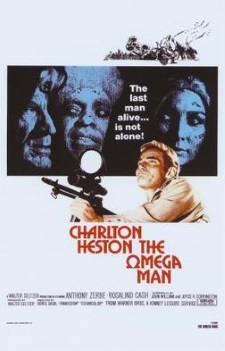

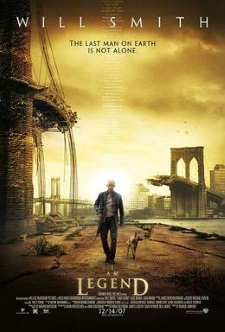
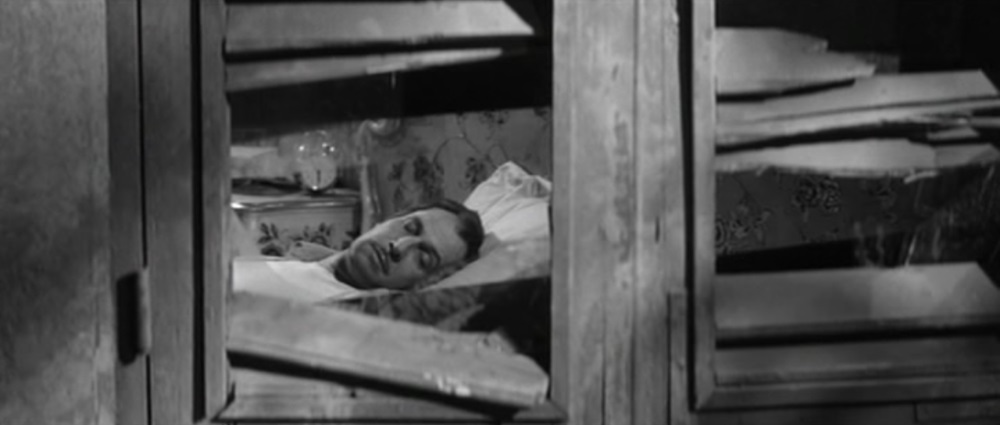
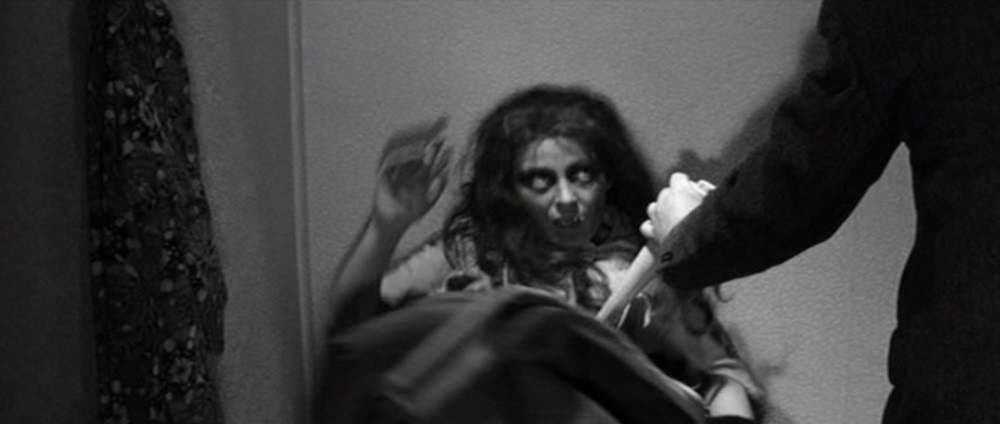


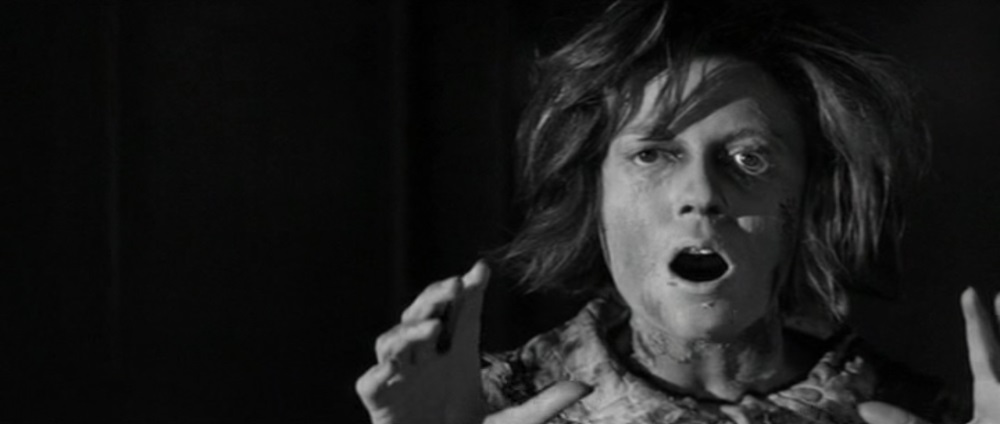


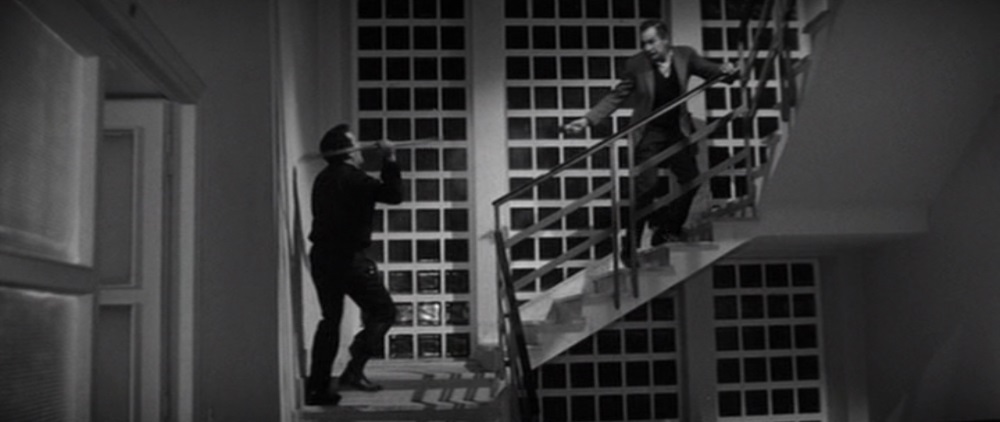
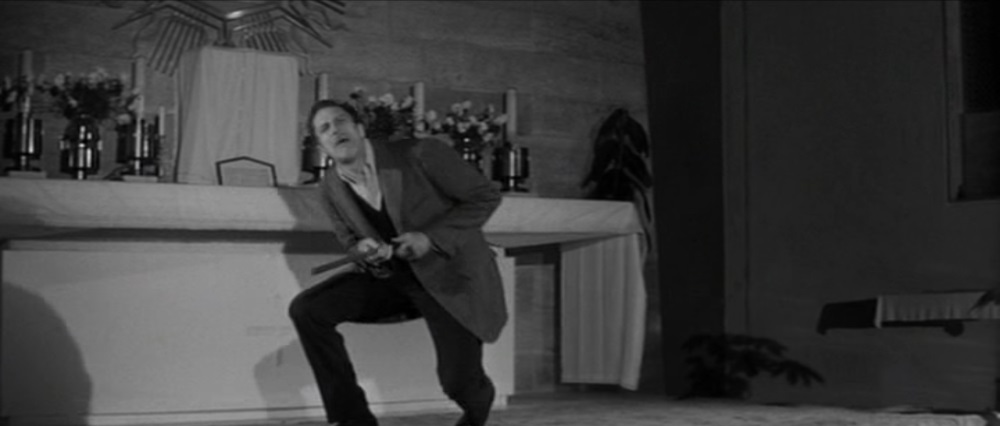

I liked your review. I too saw this when I was seven or eight, but it was on TV so maybe 1971, probably to get some air play on the heels of Omega Man. And I too had nightmares for years after – between it and The Creature From the Black Lagoon my parents forbade any more horror or sci-fi movies.
I hate continuity errors, especially when they could be avoided. I never noticed the ones you spoke of but I was eight so I wouldn’t have been as observant. But The Omega Man had three or four in the opening minutes of the movie. You can see a person walking outside on the street for a second or two, and then a minute later cars driving in the distance on a wide angle shot. The person would be impossible to edit as it was right over Heston’s shoulder in a close up. But the cars, that was just poor editing. They could have cut just before the cars showing and just maintained the image for a second or two. That’s laziness and should be pointed out. There’s much more of the same in the rest of the film.
I need to go back and watch again with this in mind. I think I wrote in this article that I rarely notice these things. But they are kind of a compliment to the filmmakers in that anyone watched closely enough to see them!
We must be the same age because Last Man on Earth and Creature from the Black Lagoon were both on TV all the time when I was a kid! I was confused when I was younger. I didn’t understand why they showed Creature all the time. But I watched it recently and I understand: it’s a great film!